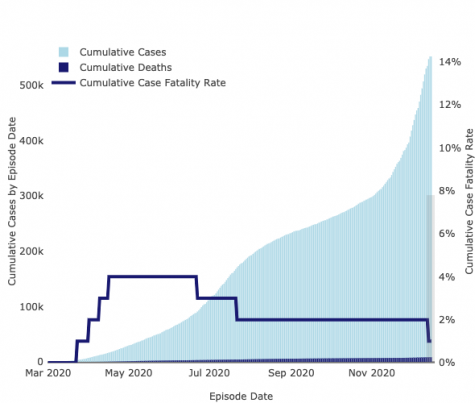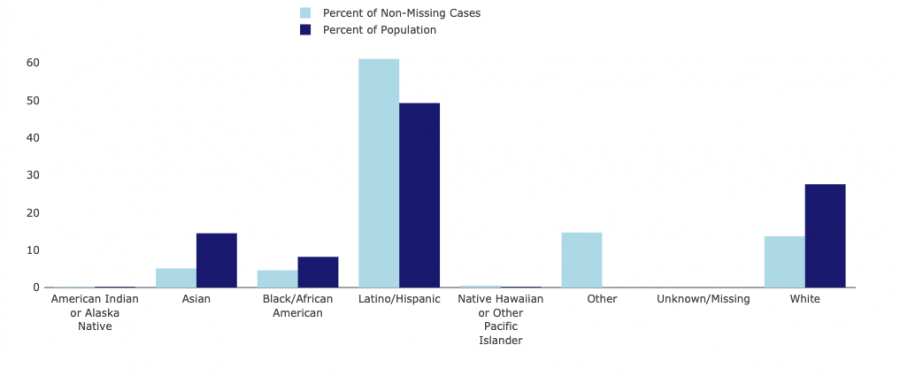COVID-19 Update: Southern California ICUs reach full capacity
December 18, 2020
Los Angeles County has the highest number of cumulative cases in the United States, while multiple other counties in California see a rise in the number of cases per capita.
The Centers for Disease Control and Prevention forecasts an upward trend in the number of deaths nationwide. L.A. County currently holds the record for the most confirmed cases in the nation.
We have compiled data and guidance from the Los Angeles County Department of Public Health to provide an update for L.A. County. Data is up to date as of Dec. 18. Here is your weekly COVID-19 update.
Local official updates:
Southern California ICUs reach full capacity
The availability of intensive care unit beds reached 0% on Thursday. Hospitals went into surge mode and had to deploy more staff to ICUs to ensure that critical patients receive care. Capacity, however, does not mean there are zero ICU beds. It means that beds are used in other areas of the hospital, according to KPCC health reporter, Jackie Fortier.
California hospitals are reporting long lines, crowded lobbies and exhausted healthcare workers.
SoCal ICU capacity reached 10% on Dec. 4, triggering a stay-at-home order. Of the patients hospitalized for COVID-19, nearly 20% end up in the ICU.
Mayor Garcetti’s daughter tests positive for COVID-19
During a briefing on Thursday, Mayor Eric Garcetti announced that his 9-year-old daughter has COVID-19 and is experiencing mild symptoms. Garcetti said his family is obeying COVID-19 protocols and quarantining at home.
“On Monday while I was at work, my wife called to let us know that our beloved daughter Maya, who turned 9 this weekend, wasn’t feeling very well,” Garcetti said. “And after she came down with a fever, we had her tested for COVID-19 and her results came back positive.”
First COVID-19 vaccines distributed in L.A. County
The first COVID-19 vaccine in L.A. County was given on Monday. California received 327,000 initial doses of the vaccine, which are being distributed to healthcare workers and long-term care residents. Helen Cordova, an ICU nurse at Kaiser Permanente Los Angeles, was one of the first in California to receive the vaccine.
The first shipment of the Pfizer vaccine arrived at Los Angeles International Airport on Sunday night on a FedEx plane after an FDA advisory panel formally recommended the authorization of the vaccine.
Los Angeles has been initially allocated nearly 83,000 doses.
Total cases:

Since the first confirmed case of COVID-19 in L.A. County on Jan. 26, the number of positive cases continues to rise. Over 5.9% of L.A. County’s population of 10 million has had COVID-19.

CSUN cases:
As of Dec. 14, there have been 55 reported cases among students and 36 reported cases among employees.
There are five reported cases among non-employee contractors.
There are no current cases that have been reported as a result of on-campus exposure.

These cases are reported to CSUN by individuals or public health officials. The university does not disclose the specific location of infected individuals for privacy reasons, but potentially exposed areas are disinfected prior to reopening.
If you test positive for COVID-19, whether or not you have been on campus, notify Yolanda Chassiakos, the CSUN Pandemic Manager, by emailing linda.reid.chassiakos@csun.edu.
Hospitalizations:
There are 5,424 COVID-19 positive patients currently hospitalized in L.A. County. There are 1,115 COVID-19 positive patients in the Intensive Care Unit. The County currently has 316 available ICU beds.
Race and ethnicity:
L.A. County’s data show that cases and deaths disproportionately affect people of color.
The L.A. County Department of Public Health reported that Latinos make up 61.1% of cases with data on race and ethnicity compared to the population, while whites account for 13.7% of cases compared to the population.
Latinos account for 52% of all COVID-19 deaths when compared to the population.
What’s open:
Grocery stores – limited to 35% capacity
Essential retail – limited to 20% capacity
Some non-essential retail with modifications
Parks and beaches with modifications
Golf courses
Hotels with modifications
Shared residential pools
Gyms – outdoors with modifications
Indoor shopping malls – limited to 20% capacity
Wineries/breweries – indoor retail only with a limit of 20% capacity
Zoos – outdoors with modifications
What’s closed:
Indoor dining at restaurants
Indoor houses of worship
Indoor gyms
Hair salons
Barbershops
Nail salons
Bars
Cardrooms
Zoos/Aquariums
Tattoo shops
Face masks are still required in public. Gatherings should be limited to only people in your household.
Testing:
The L.A. County website has a list of testing locations available for both walk-up and drive-up testing. Testing is available by appointment only.
A comprehensive map of testing locations can be found here. Hours of operation at city testing locations have been extended from 8 a.m. to 4 p.m. daily.
